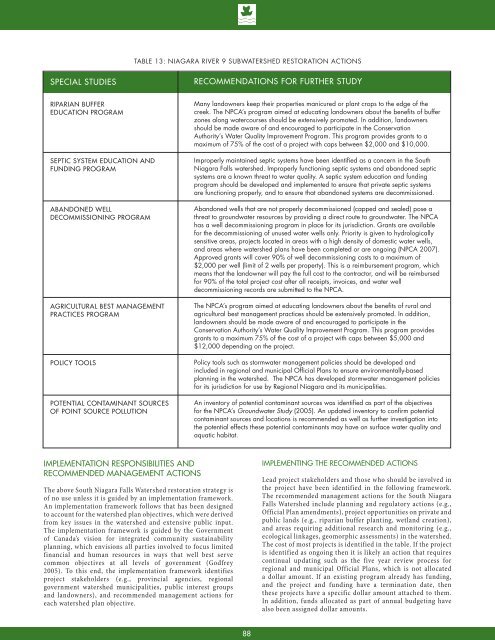8132 - NPCA SNF Watershed Report.indd - Niagara Peninsula ...
8132 - NPCA SNF Watershed Report.indd - Niagara Peninsula ...
8132 - NPCA SNF Watershed Report.indd - Niagara Peninsula ...
You also want an ePaper? Increase the reach of your titles
YUMPU automatically turns print PDFs into web optimized ePapers that Google loves.
Table 13: <strong>Niagara</strong> River 9 Subwatershed Restoration ActionsSPECIAL STUDIESRECOMMENDATIONS FOR FURTHER STUDYRIPARIAN BUFFEREDUCATION PROGRAMSEPTIC SYSTEM EDUCATION ANDFUNDING PROGRAMABANDONED WELLDECOMMISSIONING PROGRAMAGRICULTURAL BEST MANAGEMENTPRACTICES PROGRAMPOLICY TOOLSPOTENTIAL CONTAMINANT SOURCESOF POINT SOURCE POLLUTIONMany landowners keep their properties manicured or plant crops to the edge of thecreek. The <strong>NPCA</strong>’s program aimed at educating landowners about the benefits of bufferzones along watercourses should be extensively promoted. In addition, landownersshould be made aware of and encouraged to participate in the ConservationAuthority’s Water Quality Improvement Program. This program provides grants to amaximum of 75% of the cost of a project with caps between $2,000 and $10,000.Improperly maintained septic systems have been identified as a concern in the South<strong>Niagara</strong> Falls watershed. Improperly functioning septic systems and abandoned septicsystems are a known threat to water quality. A septic system education and fundingprogram should be developed and implemented to ensure that private septic systemsare functioning properly, and to ensure that abandoned systems are decommissioned.Abandoned wells that are not properly decommissioned (capped and sealed) pose athreat to groundwater resources by providing a direct route to groundwater. The <strong>NPCA</strong>has a well decommissioning program in place for its jurisdiction. Grants are availablefor the decommissioning of unused water wells only. Priority is given to hydrologicallysensitive areas, projects located in areas with a high density of domestic water wells,and areas where watershed plans have been completed or are ongoing (<strong>NPCA</strong> 2007).Approved grants will cover 90% of well decommissioning costs to a maximum of$2,000 per well (limit of 2 wells per property). This is a reimbursement program, whichmeans that the landowner will pay the full cost to the contractor, and will be reimbursedfor 90% of the total project cost after all receipts, invoices, and water welldecommissioning records are submitted to the <strong>NPCA</strong>.The <strong>NPCA</strong>’s program aimed at educating landowners about the benefits of rural andagricultural best management practices should be extensively promoted. In addition,landowners should be made aware of and encouraged to participate in theConservation Authority’s Water Quality Improvement Program. This program providesgrants to a maximum 75% of the cost of a project with caps between $5,000 and$12,000 depending on the project.Policy tools such as stormwater management policies should be developed andincluded in regional and municipal Official Plans to ensure environmentally-basedplanning in the watershed. The <strong>NPCA</strong> has developed stormwater management policiesfor its jurisdiction for use by Regional <strong>Niagara</strong> and its municipalities.An inventory of potential contaminant sources was identified as part of the objectivesfor the <strong>NPCA</strong>’s Groundwater Study (2005). An updated inventory to confirm potentialcontaminant sources and locations is recommended as well as further investigation intothe potential effects these potential contaminants may have on surface water quality andaquatic habitat.Implementation Responsibilities andRecommended Management ActionsThe above South <strong>Niagara</strong> Falls <strong>Watershed</strong> restoration strategy isof no use unless it is guided by an implementation framework.An implementation framework follows that has been designedto account for the watershed plan objectives, which were derivedfrom key issues in the watershed and extensive public input.The implementation framework is guided by the Governmentof Canada’s vision for integrated community sustainabilityplanning, which envisions all parties involved to focus limitedfinancial and human resources in ways that well best servecommon objectives at all levels of government (Godfrey2005). To this end, the implementation framework identifiesproject stakeholders (e.g., provincial agencies, regionalgovernment watershed municipalities, public interest groupsand landowners), and recommended management actions foreach watershed plan objective.Implementing the Recommended ActionsLead project stakeholders and those who should be involved inthe project have been identified in the following framework.The recommended management actions for the South <strong>Niagara</strong>Falls <strong>Watershed</strong> include planning and regulatory actions (e.g.,Official Plan amendments), project opportunities on private andpublic lands (e.g., riparian buffer planting, wetland creation),and areas requiring additional research and monitoring (e.g.,ecological linkages, geomorphic assessments) in the watershed.The cost of most projects is identified in the table. If the projectis identified as ongoing then it is likely an action that requirescontinual updating such as the five year review process forregional and municipal Official Plans, which is not allocateda dollar amount. If an existing program already has funding,and the project and funding have a termination date, thenthese projects have a specific dollar amount attached to them.In addition, funds allocated as part of annual budgeting havealso been assigned dollar amounts.88
















